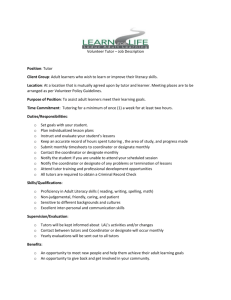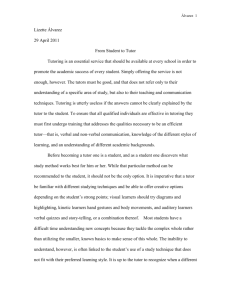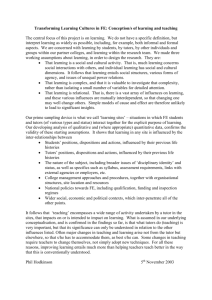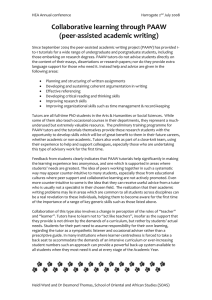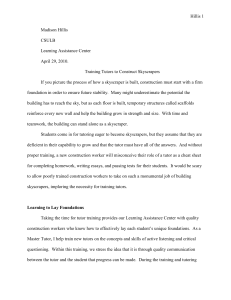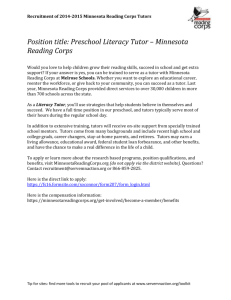doc
advertisement
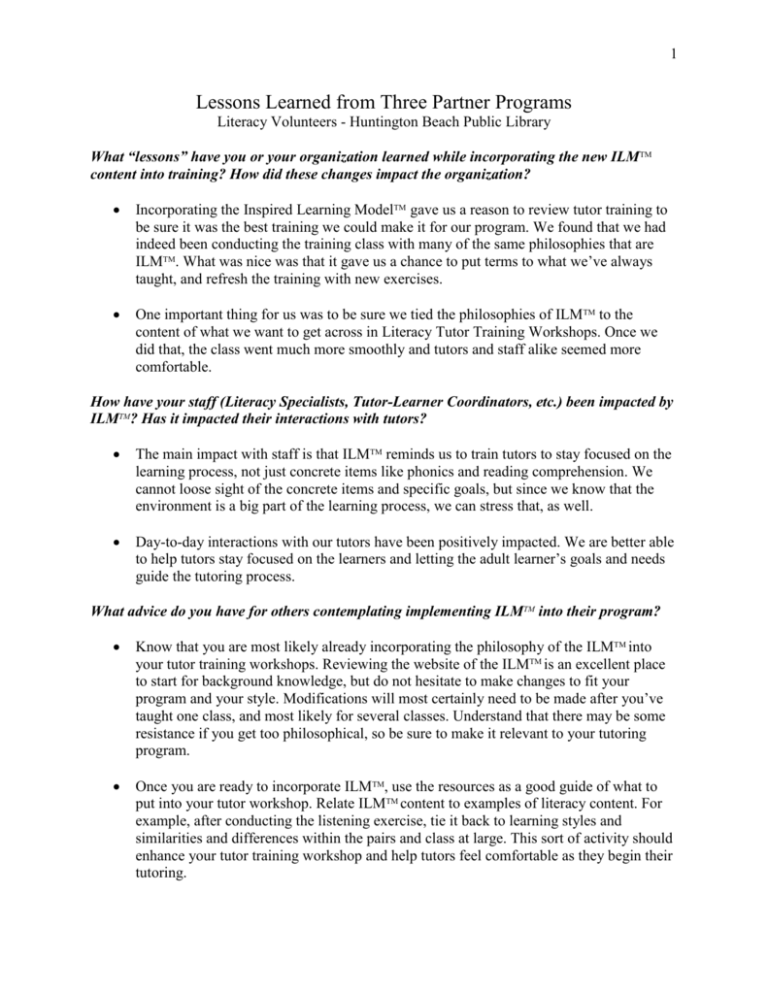
1 Lessons Learned from Three Partner Programs Literacy Volunteers - Huntington Beach Public Library What “lessons” have you or your organization learned while incorporating the new ILMTM content into training? How did these changes impact the organization? Incorporating the Inspired Learning ModelTM gave us a reason to review tutor training to be sure it was the best training we could make it for our program. We found that we had indeed been conducting the training class with many of the same philosophies that are ILMTM. What was nice was that it gave us a chance to put terms to what we’ve always taught, and refresh the training with new exercises. One important thing for us was to be sure we tied the philosophies of ILMTM to the content of what we want to get across in Literacy Tutor Training Workshops. Once we did that, the class went much more smoothly and tutors and staff alike seemed more comfortable. How have your staff (Literacy Specialists, Tutor-Learner Coordinators, etc.) been impacted by ILMTM? Has it impacted their interactions with tutors? The main impact with staff is that ILMTM reminds us to train tutors to stay focused on the learning process, not just concrete items like phonics and reading comprehension. We cannot loose sight of the concrete items and specific goals, but since we know that the environment is a big part of the learning process, we can stress that, as well. Day-to-day interactions with our tutors have been positively impacted. We are better able to help tutors stay focused on the learners and letting the adult learner’s goals and needs guide the tutoring process. What advice do you have for others contemplating implementing ILMTM into their program? Know that you are most likely already incorporating the philosophy of the ILMTM into your tutor training workshops. Reviewing the website of the ILMTM is an excellent place to start for background knowledge, but do not hesitate to make changes to fit your program and your style. Modifications will most certainly need to be made after you’ve taught one class, and most likely for several classes. Understand that there may be some resistance if you get too philosophical, so be sure to make it relevant to your tutoring program. Once you are ready to incorporate ILMTM, use the resources as a good guide of what to put into your tutor workshop. Relate ILMTM content to examples of literacy content. For example, after conducting the listening exercise, tie it back to learning styles and similarities and differences within the pairs and class at large. This sort of activity should enhance your tutor training workshop and help tutors feel comfortable as they begin their tutoring. 2 Santa Clara County Library What “lessons” have you or your organization learned while incorporating the new ILMTM content into your tutor training? How did these changes impact the organization? If a literacy program embraces a new training model emphasizing relationships and interactions as the primary instructional paradigm, all literacy staff should be a part of the initial training process. I would also suggest that organizations create ongoing opportunities for development for both staff and tutors. Before making any major adjustments to tutor training content, ensure that all of the invested team members have a universal perspective of the objectives, goals and intended outcomes for the revamped tutor training. Be sure to clearly define the outcomes that you are attempting to accomplish with this type of approach. To create more presence for the model, one person should be charged with capturing and sharing ILM-inspired outcomes by including the topic in workshops, newsletters, learner orientations, and other day-to-day program activities. It’s challenging to link a specific outcome as something solely inspired by ILMTM. Programs need to be prepared to be comfortable with some “unmeasurable” aspects inherent to this type of project. Programs with more onsite staffing to observe pairs during their first meetings may be able to better capture and reflect on this element. How have your staff (Literacy Specialists, Tutor-Learner Coordinators, etc.) been impacted by the ILMTM? Has it impacted their interactions with tutors? One staff person reported observing a few tutors introducing the guidelines during their first meetings, and she felt that these exchanges set a really positive tone for their sessions. The initial ILMTM training in September 2008 could have been offered to all staff as a professional development opportunity. This approach would have added more relevance to the guidelines through cultural integration. One tutor trainer has been positively impacted by the ILM content in both her professional and personal life; she really appreciated the active listening exercise and uses this technique regularly. What advice to you have for others contemplating implementing the ILMTM into their program? While the initial ILMTM training was helpful, I think we should have created more opportunities for staff to engage in continuous learning. Because the model is presented as an approach to build positive tutor-learner relationships, the model could have been introduced to students during a workshop or in the orientation phase. Most tutors have responded positively to the ILMTM content in tutor training, so it would be interesting to get more feedback directly from students’ points of views as well. 3 Opportunity to Read - Watsonville Public Library What “lessons” have you or your organization learned while incorporating the new ILMTM content into your tutor training? How did these changes impact the organization? Incorporating the ILMTM content into the tutor training demonstrates and creates a positive, safe learning environment that focuses on learning as an ongoing basis and allows new tutor trainees to relax into their new tutoring experience. The ILMTM is a delivery system, not a curriculum and it focuses on building the tutorlearner relationship first. This change in focus presents skills to teach reading, writing and other related literacy skills, but impacts the time allowed for other elements of the training. With practice, the tutor trainings have evolved and it takes time to settle into this new paradigm shift. Each training is different and each experience provides more insights for the correct placement of curriculum content (in the training). It is critical that the introduction to the ILMTM and the guidelines be presented at tutor trainings first. They set the stage for the entire training and we must model what we teach! Adopting ILMTM into a literacy program is also a learning experience. Be flexible, be open and be willing to try new things. After all, that is exactly what we ask both tutors and learners to do…so lead by example! The guidelines can be re-crafted keeping their core meaning and giving credit to the Foundation for Inspired Learning. It is important to be flexible and open minded to get the “buy in” from trainees. It’s difficult to capture the ILMTM on paper. It requires having receptivity to a different paradigm. Demonstrating through your personal behavior sets the example for both tutors and learners participating in your program. The purpose of the LSTA project is to address the issue of tutor attrition. Recent survey polls have shown the traditional training model would benefit from an update. We have found our tutors stay longer when they are comfortable with what is being asked of them. The Round Robin Introduction is a fun way to get to know the tutors by posing open-ended questions; these questions can lead into content that will be covered during the tutor training. The active listening exercise has been well received by tutor trainees. This activity is an excellent way to model the guidelines. Many people comment that they haven’t had the experience of talking without interruption before. This exercise gives tutor’s new insights to tutoring sessions especially the first and second meetings where they want to gather information and begin to set goals with their learner. Inviting tutors to reflect on the guidelines, to notice when they are in functioning in place during training, and to share ways to incorporate those guidelines into tutoring sessions, lesson plans, etc., helps them have experience actually integrating ILMTM concepts. Emphasizing the importance of the tutor spending more time listening to their learner and understanding the challenges and strengths of their learner encourages the tutor to utilize the most appropriate and effective curriculum based on their learner’s needs at any given time. The ILMTM approach has made tutors feel more confident about meeting their learners and knowing that the content and support will be there when it is needed. This takes off the pressure of “knowing everything.” 4 The tutor trainings have been more fun and have allowed tutors to discover new ways of approaching challenges through use of the guidelines, active listening and asking more open-ended questions. Through the monthly reflection logs of America Learns, we are able to capture data that reflects that our tutors are using the guidelines and incorporating ILM TM concepts into their tutoring sessions and lesson plans. How have your staff (Literacy Specialists, Tutor-Learner Coordinators, etc.) been impacted by the ILMTM? Has it impacted their interactions with tutors? The ILM TM guidelines and concepts provide a foundation for interacting with staff, tutors, learners, etc. It becomes a natural way of doing business. OTR has incorporated ILMTM concepts and guidelines into the Tutor Orientation, emphasizing the importance of practicing these guidelines in tutoring sessions as well as in everyday activities. The guidelines are especially helpful when tutoring small groups or when dealing with particularly sensitive situations. The interactions with tutors continue to be positive. There is more conversation around the guidelines. Tutors tend to ask more questions and understand the importance of checking in with their learners regarding what they are working on and what is important to them right now. The guidelines are a gentle reminder to keep a positive focus and acknowledge strengths and progress along the way. It’s a good reference point to use as a check in with tutors regarding their sessions. The guidelines also reflect the concepts of an equal partnership and life-long learning. The guidelines are beneficial in screening inappropriate volunteers and provide staff with excellent support for dealing with inappropriate behavior regardless of who is presenting the behavior. It also provides an excellent framework for redirecting a tutor when necessary. What advice to you have for others contemplating implementing the ILMTM into their program? The ILMTM represents an equal partnership between tutors and learners. Allow time to incorporate guidelines and concepts of the ILMTM into your training sessions. The more you integrate the ILMTM philosophy and content into the training, and model the concepts, the easier it is to share the positive affects of the ILMTM. Demonstrating – exemplifying – provides a much clearer message than just words. The ILMTM is a natural fit with adult literacy. It provides the context for building respectful rapport between the tutor and learner. It openly acknowledges the learner and their inherent strengths and does not focus on their weaknesses, thereby, creating a positive environment for life long learning. Have fun with the learning process; create activities so that tutors in training discover that there are many ways to approach tutoring, i.e. learning styles, immediate needs, long term goals and whatever works best right now.

